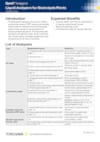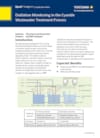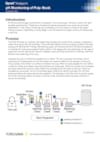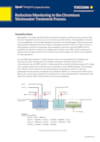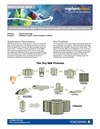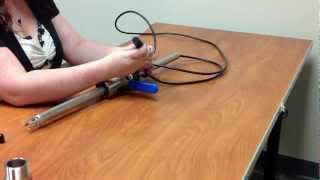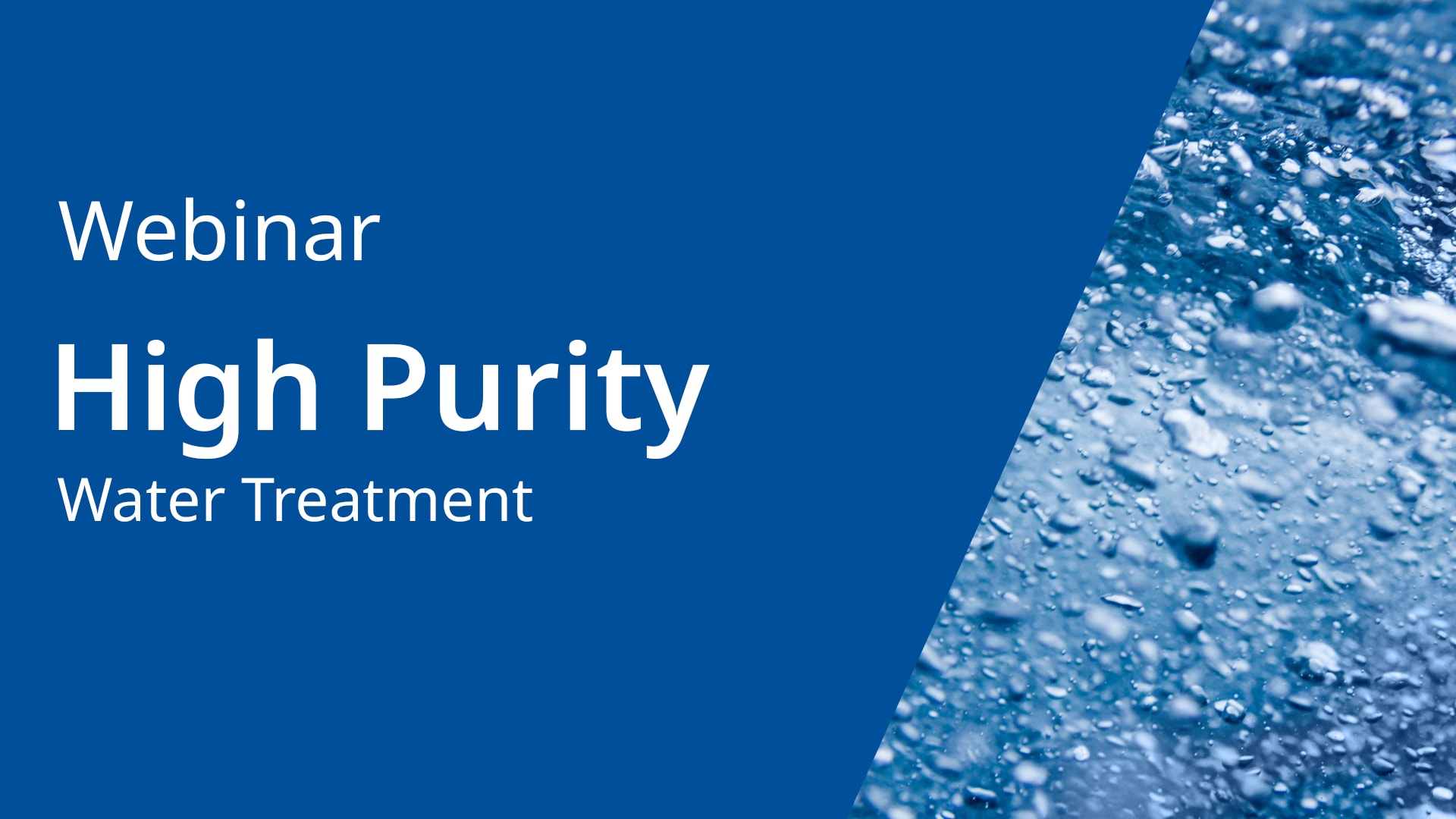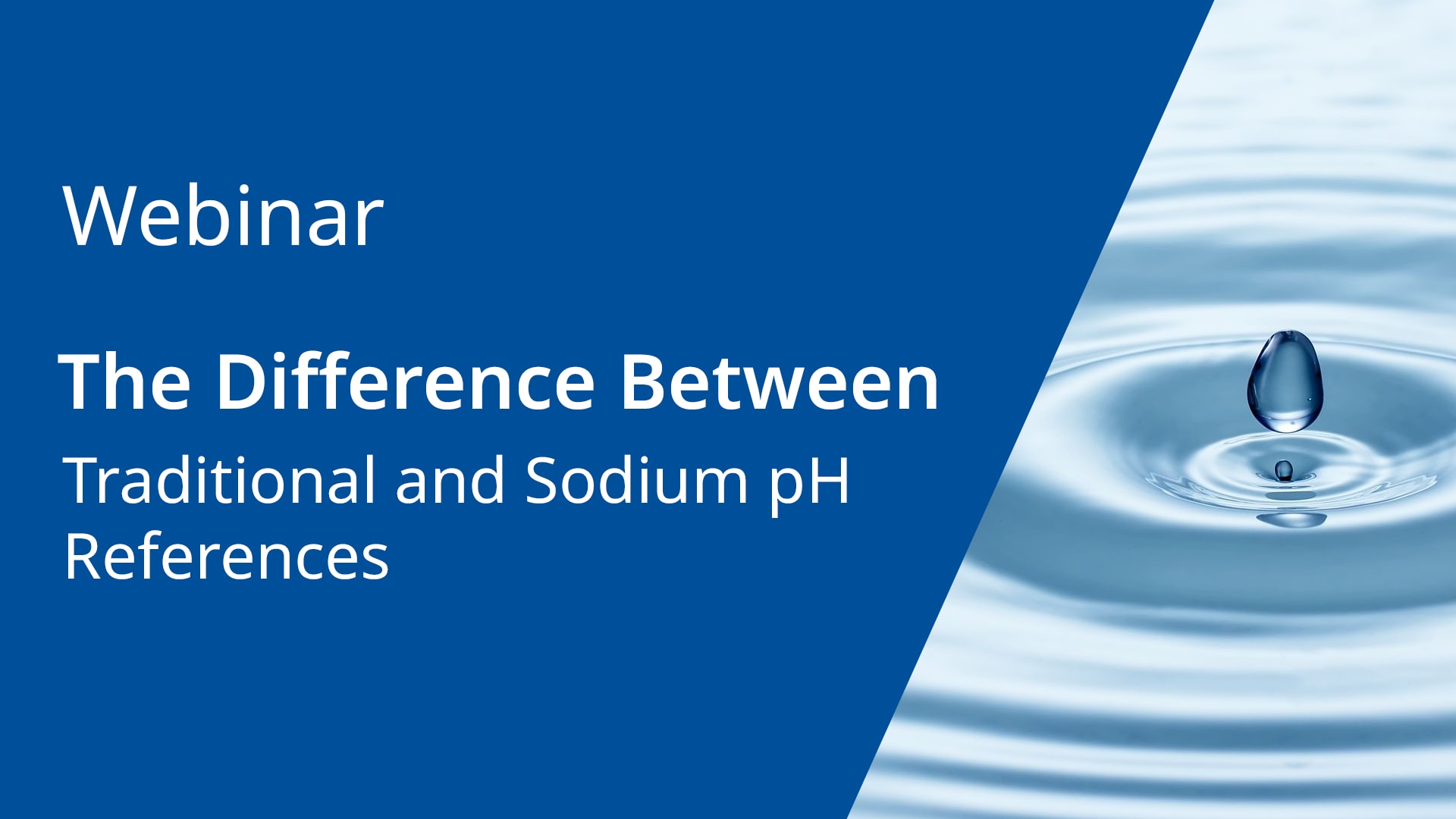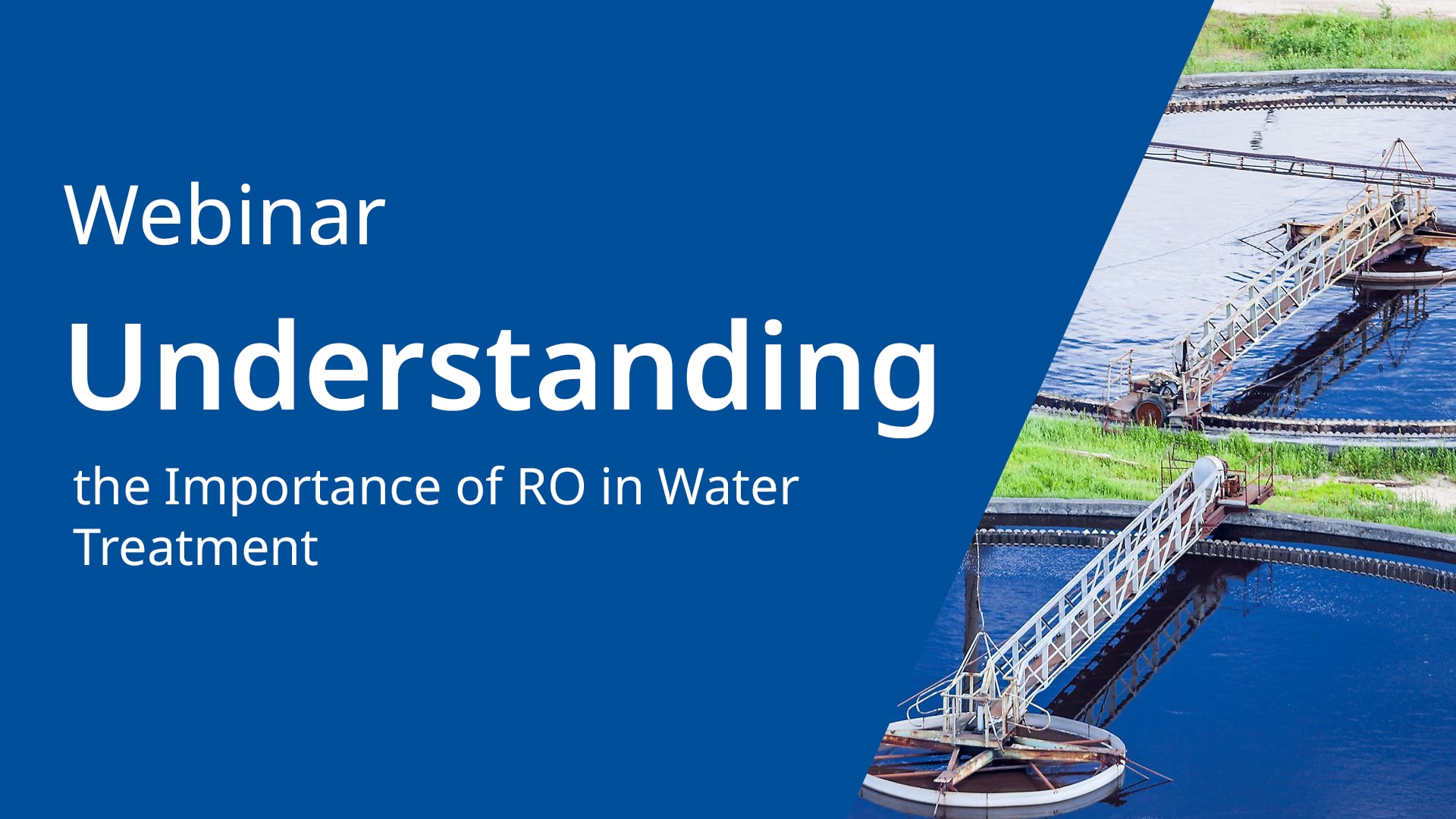pH & ORP Sensors
Ensure confidence in your fluid process operations
pH electrodes and sensors are the sensing portions of a pH measurement.
Yokogawa Industrial pH Measurement
Yokogawa offers a variety of analog and digital pH electrodes/sensors and ORP sensors to meet your application needs for inline pH or ORP monitoring of water or other fluids. Various installation options include retractable, flow thru, immersion, and direct insertion. Proper pH electrode/sensor selection is critical for optimal measurement results. View our pH quick reference poster.
-
All-in-One pH/ORP Sensor Series FU20 and FU24
The FU20 and FU24, all-in-one pH and ORP, sensors show how Yokogawa applies the motto "Simple is best" to sensor technology.
-
12mm pH Sensor SC25V
The SC25V is a pH sensor in a 12 mm design that includes an integral temperature element and a Liquid earth electrode.
-
Differential pH/ORP Sensors
The cation differential pH and ORP sensors were designed for difficult applications where conventional sensors are ineffective. These include measurements such as brine solutions to applications as diverse as electrolysis processes and cheese manufacturing.
-
Industrial pH/ORP Electrodes
The heart of a pH measuring loop is the electrode system. Yokogawa has designed a wide range of electrodes to ensure this heart keeps beating under the most severe conditions.
-
Pure Water pH and ORP Sensors
Achieving accurate and reliable readings using a traditional pH analyzer is challenging, however with the right equipment stable and accurate pure water pH measurements can be accomplished. Yokogawa's specialized bellomatic pH sensor is proven best solution for high purity water applications. For those individuals that do not like the maintenance of refilling sensors, then the FU24 which incorporates the successful patented bellow system in an All-in-one body is the ideal solution.
-
Personal Handheld Meter PH71/PH72
The PH71/PH72 pH and/or ORP meter is a Compact, Easy-to-use, Drip proof – Ideal for Field Use. Features "One-Touch Calibration" and Temperature Compensation. Laboratory-Grade Intelligent pH Meters – Sized and Priced to Fit in Your Pocket
-
Pharmaceutical pH and ORP Electrodes and Fittings
These sensors feature the latest innovations in pH glass formulation, reference systems, and reference electrolytes. They offer supperior accuracy and stability, even after repeated sterilizations.
-
pH/ORP Retractable PH87/PH97
The PH87 retractable assembly is suitable for "Hot-Tap" service, allowing for removal from a pressurized process line or vessel without interrupting the flow or draining the tank. The housing assemblies are constructed of chemically resistant titanium sheathes and are used with Model PH97 rugged sensors.
-
EXAtrac RF20 Pneumatic Retractables
The pneumatic retractable holder EXAtrac RF20 (Extrac 810 and 820) is made for installation of 12mm sensors on tanks or pipelines where the sensor has to be removed without interruptions or shutdowns and in the hash applications where frequent cleaning is of vital importance for a good pH measurement.
-
pH and ORP Applications with Coating Problems
A pH electrode is as good as its maintenance; this is especially true in harsh environments. For industrial applications and particularly for automatic process measurements, it is of the greatest importance that the sensitive part of a glass electrode and the diaphragm of a reference electrode are kept clean.
-
pH/ORP Buffer Calibration Solutions
Buffer solutions are needed as an indispensable tool for maintaining an accurate pH measurement. Buffer solutions are used as references points for calibration and adjustment of pH measurements to compensate for aging and deterioration.
-
Product Finder
This web tool makes it easier to find products according to the application, measurement conditions and required specifications.
Details
pH and ORP Analyzers
| FLXA402 | FLXA202/FLXA21 | |
|---|---|---|
| Area Classification | General Purpose Class I Div II |
General Purpose Class I Div I Class I Div II |
| Power Supply | 110VAC, 24VDC (4-wire) |
24VDC loop-powered (2-wire) |
| Communication | 4-20mA, HART, Modbus (Ethernet, RS-485), Bluetooth |
4-20mA, HART, FF and PA* |
| Contacts and Relays | 4 SPDT relays | None |
pH/ORP Calibration Solutions
Either of these pH buffer solutions can be used for calibration of an ORP measuring system and are very practical if pH loops are also being maintained
-
Pre-made Stabilized ORP Solutions
Premade solutions designed to provide a specific stable mV value, typically one that falls within the process ORP range
- Quinhydrone Solution
Solutions made using the standard pH 4 and pH 7 buffers with quinhydrone crystals mixed in until saturation is reached
Resources
- More than 1,000 field devices designed to the PROFIBUS specifications installed in the state-of-the-art water reclamation plant.
- The high reliability and accuracy of our field devices contributes to the minimization of maintenance costs over the entire plant lifecycle.
Yokogawa & Nouryon Co-Innovation Leads to New pH-Analyzer
For control of batch neutralization, a pH measurement coupled with a timer-controlled chemical feed scheme provides very satisfactory results.
This system can be adapted for either acid waste or alkaline waste neutralization.
Dairy wastewater is a mixture of organic compounds, suspended solids, fats, and bacteria that can produce a film or coating on equipment in the process.
There are many points in the processing of edible fats and oils that benefit from the use of analytical measurements. Inductive conductivity, contacting conductivity, gas density, and pH can be utilized to increase the quality of the end product, as well as protecting expensive processes.
The proliferation of microorganisms and the resultant formation of slime is a problem which commonly occurs in aqueous systems. Problematic slime producing microbes may include bacteria, fungi and/or algae. Slime deposits typically occur in many industrial aqueous systems including cooling water systems, pulp and paper mill systems, petroleum operations, clay and pigment slurries, recreational water systems, air washer systems, decorative fountains, food, beverage, and industrial process pasteurizers, sweetwater systems, gas scrubber systems, latex systems, industrial lubricants, cutting fluids, etc.
Industry:Refining, Food and beverage, Power, Oil and Gas, Pulp and Paper, Chemical
Measurement of pH in high purity water presents many difficulties. Yokogawa's pH instrument's design success comes from addressing the unique challenges of the application.
Process liquid analyzers such as pH meters, conductivity meters, ORP meters, and density meters play an important role at electrolysis plants in the control of concentrations of various process solutions. This requires both precision and stability under harsh conditions that include highly corrosive substances, high temperatures, and many impurities.
Most zinc are produced at hydrometallurgically, where a high-grade zinc product can be obtained and valuable metals mixed in the raw material can be recovered. In the hydrometallurgy, the raw material of zinc concentrate is roasted and then dissolved in sulfuric acid to remove impurities. The process called leaching and pH control of the leachate is important.
Industry:Chemical, Power
Cyanide-bearing wastewater from mining and electroplating facilities and certain types of chemical plants is toxic and must be treated by oxidation with chlorine or chloride to bring the cyanide concentration within regulatory limits.
Industry:Electrical and Electronics
In flue gas desulfurization systems that use magnesium hydroxide (Mg(OH)2) slurry, the consumption of the desulfurization agent (Mg(OH)2) is controlled by using online pH analyzers. A great concern in the pH measurement is heavy staining of the pH electrodes by the Mg(OH)2 slurry. To ensure accurate measurement, frequent cleaning of the electrodes with an acid is required, adding to both maintenance workload and cost.
Industry:Chemical, Power
The treatment of wastewater from pulp and paper plants is a serious environmental concern. Yokogawa's submersion holder with an ultrasonic+air-jet cleaner (customized product) can reduce the manual cleaning frequency to just once every one or two months.
Continuous technology improvement is ongoing in the pulp & paper industry to obtain the best possible performance. Problems at the wet end (stock preparation) can rarely be corrected downstream. That is why monitoring and controlling pH in pulp stock is critical to the paper making process. Essentially, at every stage in the manufacture of paper, correct pH values play a vital role.
Reverse osmosis (RO) is a separation process that uses pressure to force a solution through a membrane that retains the solute on one side and allows the pure solvent to pass to the other side. More formally, it is the process of forcing a solvent from a region of high solute concentration through a membrane to a region of low solute concentration by applying a pressure in excess of the osmotic pressure.
Wastewater from electroplating facilities and certain types of chemical plants contains toxic forms of hexavalent chromium such as chromate and dichromate. The hexavalent chromium in this wastewater must be reduced before the water can be discharged. This requires a two-step process: hexavalent chromium (CR6) is reduced to trivalent chromium (CR3); and CR3 is precipitated as chromium hydroxide.
Industry:Electrical and Electronics
Sour Water is the wastewater that is produced from atmospheric and vacuum crude columns at refineries. Hydrogen sulfide and ammonia are typical components in sour water that need to be removed before the water can be reused elsewhere in the plant.
Power plant boiler houses designed to burn coal or high sulfur oil are required by Federal and State pollution regulations to "scrub" (remove) sulfur dioxide from flue gasses to meet emission limits. SO2 in flue gasses is known to be harmful to the environment, as it is one contributor to the formation of acid rain. pH control is critical for the proper functioning of the scrubber system.
The quality of paper for printing or writing should be high and it depends on many parameters. Cobb is one of the parameters, which requires control. Using a retractable fitting, this optimum pH level can be achieved by using Yokogawa's 4-wire pH Analyzer with a suitable, retractable fitting and sensor. Since a separate controller is not required for the dosing pump, this solution provides a cost-saving.
Wastes have been considered to be a serious worldwide environmental problem in recent years. Because of increasing pollution, these wastes should be treated. However, industrial wastes can contain a number of valuable organic components. Recovery of these components is important economically. Using conventional distillation techniques, the separation of acetic acid and water is both impractical and uneconomical, because it often requires large number of trays and a high reflux ratio. In practice special techniques are used depending on the concentration of acetic acid.
Yokogawa’s Process Liquid Analyzers series help pigment producers achieve a more reliable and accurate analysis of pH during industrial bioprocesses, improving product quality with less total operation costs.
Many Ethanol plants running today are using a combination style pH electrode with a non-flowing reference to measure pH in the Mash Slurry transfer line from the Mash slurry mix tank to cook. The Mash is being pumped out of the Mash Slurry tank is at approximately 180 °F and 40 to 60 psig.
Optimizing four key factors will decrease pH sensor costs and optimize process control and overall plant efficiency.
ORP (Oxidation-Reduction Potential) is the measurement, in millivolts, of a solution's capacity for electron transfer (oxidation or reduction). ORP measurement may also be called REDOX for REDuction OXidation. The name reflects that fact that within a chemical reaction reduction and oxidation are complementary; one cannot occur without the other.
Why should leaders act on Digital Transformation, Autonomous Operations, and Smart Manufacturing? - Food Processing - eHandbook March 2022
The lifetime of a pH sensor has a significant impact on the overall annual costs of a pH measuring loop. Optimizing four key factors will decrease these costs and optimize process control and overall plant efficiency.
- Base Chemical
- Biomass Power
- Chemical
- Cogeneration
- Combined Cycle
- Desalination
- Drinking Water Treatment
- Energy Transition
- Food & Beverage
- Geothermal Power
- Hydro Power
- Industrial Water
- Iron & Steel
- LNG Liquefaction
- LNG Regasification & Storage
- LNG Supply Chain
- Mining & Metal
- Nuclear
- Ocean Thermal Energy Conversion
- Oil & Gas Downstream
- Petrochemical
- Pharmaceutical
- Power
- Processing & Fractionation
- Pulp & Paper
- Refining
- Specialty & Fine Chemical
- Water & Wastewater
Kind of. Calibration itself will not extend the life of a sensor, however, a sensor that is not calibrated properly can cause unreliable measurements - that are often misdiagnosed leading to unnecessary replacements.
- Base Chemical
- Biomass Power
- Chemical
- Cogeneration
- Combined Cycle
- Desalination
- Drinking Water Treatment
- Energy Transition
- Food & Beverage
- Geothermal Power
- Hydro Power
- Industrial Water
- Iron & Steel
- LNG Liquefaction
- LNG Regasification & Storage
- LNG Supply Chain
- Mining & Metal
- Nuclear
- Ocean Thermal Energy Conversion
- Oil & Gas Downstream
- Petrochemical
- Pharmaceutical
- Power
- Processing & Fractionation
- Pulp & Paper
- Refining
- Specialty & Fine Chemical
- Water & Wastewater
Optimizing the maintenance cycle is not always straightforward. In some cases, cleaning once a week is sufficient and other processes may require every 8 hours.
- Base Chemical
- Biomass Power
- Chemical
- Cogeneration
- Desalination
- Drinking Water Treatment
- Energy Transition
- Food & Beverage
- Geothermal Power
- Hydro Power
- Industrial Water
- Iron & Steel
- LNG Liquefaction
- LNG Regasification & Storage
- LNG Supply Chain
- Mining & Metal
- Nuclear
- Ocean Thermal Energy Conversion
- Oil & Gas Downstream
- Petrochemical
- Pharmaceutical
- Power
- Processing & Fractionation
- Pulp & Paper
- Refining
- Specialty & Fine Chemical
- Water & Wastewater
Learning these four lessons will help you improve your engineering skills and most importantly extend the life of your pH sensors.
- Base Chemical
- Biomass Power
- Chemical
- Cogeneration
- Combined Cycle
- Desalination
- Drinking Water Treatment
- Energy Transition
- Food & Beverage
- Geothermal Power
- Hydro Power
- Industrial Water
- Iron & Steel
- LNG Liquefaction
- LNG Regasification & Storage
- LNG Supply Chain
- Mining & Metal
- Nuclear
- Ocean Thermal Energy Conversion
- Oil & Gas Downstream
- Petrochemical
- Pharmaceutical
- Power
- Processing & Fractionation
- Pulp & Paper
- Refining
- Specialty & Fine Chemical
- Water & Wastewater
Select the correct pH glass and reference type to improve your pH sensor lifetime and you can limit or even eliminate the effects of temperature and pressure on especially the reference sensor.
- Base Chemical
- Biomass Power
- Chemical
- Cogeneration
- Combined Cycle
- Desalination
- Drinking Water Treatment
- Energy Transition
- Food & Beverage
- Geothermal Power
- Hydro Power
- Industrial Water
- Iron & Steel
- LNG Liquefaction
- LNG Regasification & Storage
- LNG Supply Chain
- Mining & Metal
- Nuclear
- Ocean Thermal Energy Conversion
- Oil & Gas Downstream
- Petrochemical
- Power
- Processing & Fractionation
- Pulp & Paper
- Refining
- Specialty & Fine Chemical
- Water & Wastewater
Downloads
Brochures
- Analytical BioTech Pharma BU (1.6 MB)
- Liquid Analyzers in the Water Industry
- Model FU20 Challenging and Harsh Applications Widebody Type pH and ORP Sensors (503 KB)
- Process Analyzers Analytical Instruments and Systems Overview
- Model FU24 Challenging and harsh applications widebody type pH and ORP sensors (8.3 MB)
- Electrolysis Solutions: Instrumentation Solutions for Electrolysis Plant Applications (841 KB)
- Liquid Analyzer Sensors and Fittings (5.9 MB)
- Water Industry Solutions (739 KB)
- PH71/PH72/SC72 Personal pH, pH/ORP, Conductivity Meters (1.8 MB)
- FLXA402 4-Wire Liquid Analyzer, SA11 SENCOM Smart Adapter (2.9 MB)
- EXA450 The Next Evolution in Liquid Analyzers (571 KB)
- Yokogawa in the Water Industry in North America (2.2 MB)
- pH Quick Tips Infographic Poster (288 KB)
Instruction Manuals
- SM21 pH Measuring Electrodes (518 KB)
- Model FF20 Flow fittings Model FS20 Subassembly flow fittings Model FD20 immersion fitting (3.4 MB)
- PUS400G Ultrasonic Oscillator (1.3 MB)
- PH402 Four-Wire pH/ORP Analyzer (1.8 MB)
- Model FU24F pH/ORP SENCOMR sensor (1.3 MB)
- PR20 Retractable Hot-Tap Fitting for pH/ORP (707 KB)
- SR20-AC32 Bellowmatic Manual (27 KB)
- Directions for use Temp. Electrodes (149 KB)
- PH8ECP KCl Filling Type pH Sensor (for electrolysis plant) (481 KB)
- PH8ERP KCl Refillable type pH Sensor (715 KB)
General Specifications
- pH/ORP Catalog (3.2 MB)
- pH and ORP Sensors (1.6 MB)
- *Discontinued: SENCOM FU20F / FU24F / SC25F Digital pH/ORP-sensor (3.7 MB)
- Chemical Cleaning pH Measuring System (971 KB)
- FLXA402 4-Wire Converter (1.4 MB)
- Sensor Holders (3.2 MB)
- RF20H Pneumatic Retractable (663 KB)
- EXAtrac Series Retractable Holder (1.0 MB)
Technical Information
- Cation Reference Explained (1.1 MB)
- Best Practice Layup Procedure Guide (316 KB)
- Pure Water Explaination of Benefits (382 KB)
- pH/ORP Analyzer Selection Guide (726 KB)
- Cation Differential Quick Start Guide (1.4 MB)
- Choosing the Right Electrodes (720 KB)
- Process Liquid Analyzer Sensor Wiring Guide
- FU24 Cleaning options (145 KB)
- Maintaining Yokogawa pH Monitoring System
- PR10 Quick Start pH Guide (823 KB)
- Sensor Diagnostics
- Variopin Wiring Comparison (123 KB)
- Back to the pHuture - pH and ORP Learning Handbook (8.3 MB)
Certificates
- FU20 CE Certification (317 KB)
- SM21, SR20 and SM60 CE Declaration Statement
- FU24 CE (294 KB)
- Mercury Free Declaration (101 KB)
- PH20 CE (329 KB)
- SENCOM Sensors ATEX Certification (2.0 MB)
- SENCOM Sensors CSA Certification (115 KB)
- SENCOM Sensors FM Certification (167 KB)
- SENCOM Sensors IECEx Certification (1.7 MB)
- Shelf Life Statement (40 KB)
Engineering Tools
- FU24F Digital pH/ORP Dimensional Drawing (85 KB)
- SC25F Digital SENCOM® pH Sensor (179 KB)
MSDS/SDS
- Safety Data Sheet K1220QT / Electrolyte for individual and combined pH and ORP sensors
- 238227 & 238322 -HAMILTON 475 mV ORP Buffer Solution (175 KB)
- K1520BK - Sodium buffer solution pH 9.00 (+/-0.02) natural (240 KB)
- K1520BG - Buffer solution NA pH 2.00 (+/-0.02) natural (254 KB)
- 238228 - HAMILTON 271 mV ORP Buffer Solution (113 KB)
- K1520BH - Sodium buffer solution pH4.00(+/-0.02) naturel (243 KB)
- K1520BJ - Buffer solution NA pH 7.00 (+/-0.02) natural (219 KB)
- K1520BE - Standard buffer pH 9.18 kit, yellow (233 KB)
- K1520BD - Buffer solution pH 6.87 kit, orange/yellow (231 KB)
- K1520BC - Buffer solution pH 4.01 kit, red/pink 3 x 500 ml (220 KB)
- K1520BB - Buffer solution pH 1.68 kit, green/blue 3 x 500ml (240 KB)
- K9220XE / K9084KG / K9084LM - pH7 Standard solution (165 KB)
- K1520BG - 2.00 pH buffer solution with Na (51 KB)
- K9020XU / K9146CA / K9142UT - KCl powder (458 KB)
- K9020XA / Powder for buffer solution (pH4) (280 KB)
- K1520BH - 4.00 pH buffer solution with Na (48 KB)
- K9220XD / K9084KF / K9084LL - pH4 Standard solution (180 KB)
- K9020XB / Powder for buffer solution (pH7) (281 KB)
- K9020XC / Powder for ph9 standard solution (251 KB)
- K9084KH, K9084LN / pH9 standard solution (189 KB)
- K1520BJ - 7.00 pH buffer solution with Na (48 KB)
- K9024ED / Reagent for ammonium iron sulfate solution (173 KB)
- K9220XH/ K9084KQ/ K9084KS/ K9084LP / 3.3M KCl solution (182 KB)
- K1520BK - 9.00 pH buffer solution with Na (48 KB)
- NIST Buffer Solutions: M1100EU, M1200HQ, M1200HR, M1200HS, M1263VM, M1263VN, M1263VP (223 KB)
Videos
Glass blown pH electrodes at Yokogawa Europe.
How to install a Bellomatic probe in a holder and perform necessary maintenance.
While we strive to provide the most safe and accurate information possible, we are not responsible for any loss or damages resulting from attempting to replicate the acts conducted in this video. Furthermore, we shall not be held liable for use or misuse of information contained in this video.
This video covers a PR10 installation and extraction. While we strive to provide the most safe and accurate information possible, we are not responsible for any loss or damages resulting from attempting to replicate the acts conducted in this video. Furthermore, we shall not be held liable for use or misuse of information contained in this video.
We invited Nick Crowe, our Product Manager for Analytical Products to debunk myths around Liquid Analysers. In part 1 of this series, Sean asked him whether the maintenance-free analyzer is a myth?
Are Pure water, Ultrapure water, UPW, or Water for Injection (WFI) important in your process? Would a better understanding of current water treatment equipment technology be useful? Would learning to better identify sources for potential process problem be helpful?
Pure water, Ultrapure water, UPW, Water for Injection (WFI), high-purity water and deionized (DI) are all terms describing basically the same property. They refer to water which has been purified to the highest standards by removing all contaminants such as, organic and inorganic compounds; dissolved and particulate matter; volatile and non-volatile, reactive and inert; hydrophilic and hydrophobic; and dissolved gases. Pure water or conditioned water is used in a variety of processes across various industries; Power Generation, Pharma/Biotech, Semiconductor, and Drinking water are just a few examples. Please join us for a free 45 min webinar with 15 min Q&A section. As our presenter David H. Paul, Inc (DHP), gives an overview of high purity water treatment. What you will learn:
- Understanding the purpose for each piece of equipment in a high purity treatment process flow
- Basic overview of Reverse Osmosis Processes
- Better understanding of when to "raise an alarm" when performance issues arise
Information about the presenter: Since 1988, David H. Paul, Inc (DHP) has been the world's leader in reverse osmosis and high purity water treatment training. DHP has trained over 18,000 water treatment professionals worldwide. For information on additional High Purity Water Treatment and Reverse Osmosis Water Treatment training please click on the link to DHP's website: www.dhptraining.com
Proper pretreatment is critical for minimizing problems and reducing the need for chemical cleaning. This webinar will teach you the most common pretreatment technologies and why it is important to monitor and maintain them. Join us to learn:
- Why pretreatment is important
- How pretreatment protects your RO units from scaling, fouling and chemical attacks
- What to monitor and why
Watch this on-demand webinar to review and learn the theory behind pH measurement, the issues surrounding high purity pH measurements, and how to implement good calibration and maintenance procedures.
What about other instrumentation pain-points in the blow tank, washing, or bleaching process?
In the digester process, high temperature and pressure, along with the slurry pulp, can cause extreme damage to traditional meters.
This video aims to answer the following: How does a traditional pH reference work and what are it's common problems? How does a sodium pH reference work and what are it's benefits? This webinar was presented February 12th, 2013.
Each of the previous webinars covered the basics and the monitoring requirements for a high purity water treatment system that included a Reverse Osmosis (RO) treatment step. In this final webinar, we cover the problems that poor RO unit performance can produce in downstream process steps and in the end use water. The webinar series started with topics concerning raw water contaminants and will end with following contaminants through the RO membrane and into downstream treatment steps including Electrodeionization (EDI), mixed-bed ion exchange, 185 nm and 254 nm UV, ozone and more. Join us and learn:
- What and why certain measurement parameters should be monitored
- When to "raise the alarm" when issues arise
A common use for RO is for purifying water, removing salts and other impurities to improve the color, taste and other properties. It is regularly used for commercial and residential water filtration and is also one of the methods used for desalinization of seawater. RO systems are capable of rejecting bacteria, salts, sugars, proteins, particles, dyes, and other constituents which have a molecular weight of greater than 150-250 Daltons. RO systems are designed for automatic operation and require routine preventative and corrective maintenance. Common problems include membrane fouling and the use of improper flow rates. The result is reduced throughput capacity and shortened runs. What you will learn:
- Overview of Reverse Osmosis Processes
- Understanding of RO technology
- Understanding the importance of RO operation and maintenance
News
-
Press Release Mar 28, 2012 Yokogawa Releases pH Sensor with Built-in Temperature Sensing and Liquid Earth
Looking for more information on our people, technology and solutions?
Contact Us









